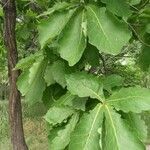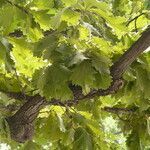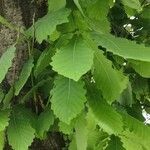Trees to 30 m tall, deciduous. Branchlets purple-brown, angular, glabrous, lenticellate. Petiole 2-8 mm, glabrous; leaf blade obovate to narrowly so, (5-)7-19(-23) × (2-)3-11 cm, hairy along veins, glabrescent, base narrowly rounded to auriculate, margin with (5-)7-10 undulate to rough serrations on each side, apex truncate, shortly mucronate, or cuspidate; secondary veins (5-)10-18 on each side of midvein; tertiary veins abaxially slender, evident. Female inflorescences axillary on apical part of young shoot, 0.5-2 cm; cupules 4 or 5 but usually only 1 or 2 fertile. Perianth 6-lobed. Cupule cupular, 0.8-1.5 × 1.2-1.8(-2.8) cm, enclosing 1/3-1/2 of nut; bracts basal from cupule rim triangular-ovate, abaxial surface semiglobose tuberculate, sparsely to densely grayish pubescent; bracts at rim of cupule patent, margin fimbriate. Nut narrowly ovoid, ovoid, or ovoid-ellipsoid, (1.5-)2-2.4 × (1-)1.3-1.8(-2.3) cm, glabrous except for apex; scar 5-8(-13) mm in diam., slightly raised; stylopodium ca. 1 mm in diam. Fl. May-Jun, fr. Sep-Oct.
More
A tree. It grows to 30 m tall. It spreads 12 m wide. It loses its leaves during the year. The small branches are purple-brown and angular. The leaf stalk is 2-8 mm long. The leaf blade is narrow and oval. It is 7-19 cm long by 3-11 cm wide. Leaves are hairy along the veins. The base is narrowly rounded or ear shaped. The edges of the leaf have rough teeth or are wavy. There are 10-18 side veins on each side of the main vein. The cup half encloses the nut. The nut is narrow and oval. It is 2-2.4 cm long by 1.3-1.8 cm wide.




